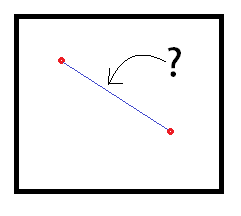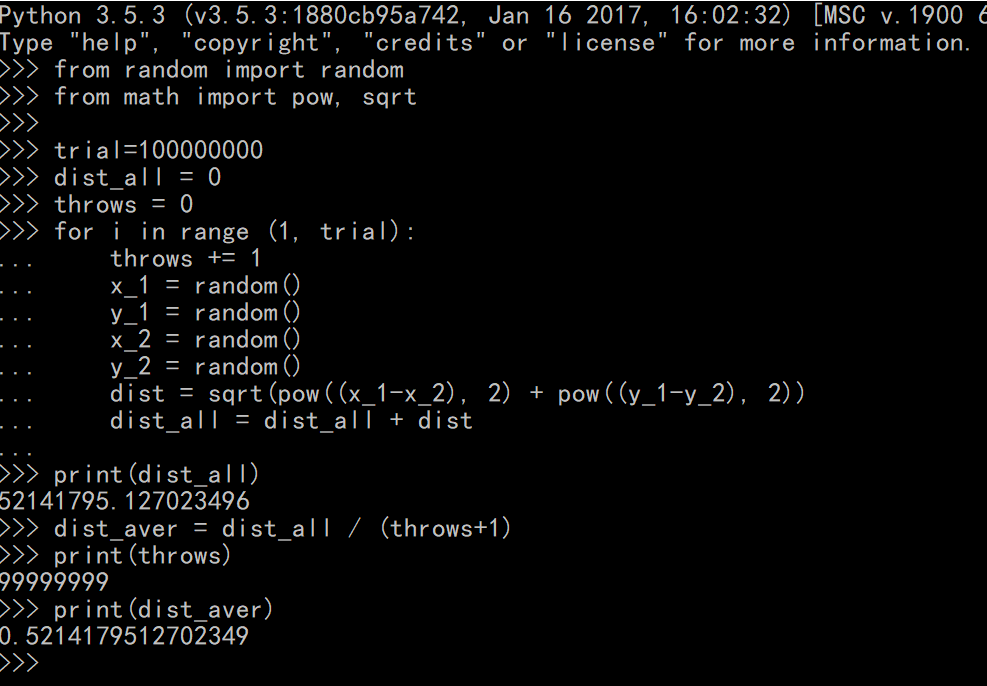Average Distance Between Two Points
 Suppose you have a
1
×
1
square. If two points are randomly picked within the square, what is the expected value (average) of the distance between them, rounded to 4 decimal places?
Suppose you have a
1
×
1
square. If two points are randomly picked within the square, what is the expected value (average) of the distance between them, rounded to 4 decimal places?
The answer is 0.5214.
This section requires Javascript.
You are seeing this because something didn't load right. We suggest you, (a) try
refreshing the page, (b) enabling javascript if it is disabled on your browser and,
finally, (c)
loading the
non-javascript version of this page
. We're sorry about the hassle.
8 solutions
this would sum up all the distances, but how do you calculate the average? do you simply divide by the area (which is 1 in this case and hence does not affect the solution) ?
We can use a Monte Carlo Simulation , and simply randomly pick points in the square, compute their distance, and average this for many points:
Python 3.3:
1 2 3 4 5 6 7 8 9 10 11 12 |
|
I posted this problem under computer science because the manual method for doing this involves some pretty nasty calculus. I also put "Correct to 4 places after the decimal" so that your computers would have to crank for a good few seconds.
This can (I don't know any other way) be done rather simply by sampling tons of pseudo-random points via a Monte Carlo simulation. With that said, your pseudo-random number generating algorithm must produce uniformly distributed numbers. For my solution, I used the well known Mersenne Twister algorithm.
Pardon my c++ by the way.
Here is the header file mrand.h , and the library file mrand.cpp .
#include "mtrand.h"
#include <cmath>
#include <ctime>
#include <stdio.h>
struct point{ //to help with readability
point(double X, double Y):x(X),y(Y){};
double x;
double y;
};
double square(double x){ //I don't like the standard pow(X,n) function
return x*x;
}
double distance(const point& a, const point& b){ //calculate and return the distance between a & b
double Y = b.y - a.y;
double X = b.x - a.x;
return (sqrt((square(Y)) + (square(X))));
}
int main() {
int seed = time(NULL); //set random seed
MTRand rand_num(seed); //initialize generator
double Box_X = 1.; //box width
double Box_Y = 1.; //box height
double expected_dist = 0; //start off the expected distance
int N = 2000000; //number of samples
double N_inv = 1. / ((double)N); //multiplication is faster than division
point A(0,0); //initialize the points we'll be manipulating
point B(0,0);
for (int i=1; i<N; ++i){
A = point(rand_num(),rand_num());
B = point(rand_num(),rand_num());
expected_dist+=distance(A,B); //sum the distances
}
expected_dist*=N_inv; //get the average
printf("The expected distance is : %.9fl ",expected_dist); //print result
return 0;
}
The exact answer is 1 5 2 2 + 2 + 5 l n ( 2 + 1 ) )
Log in to reply
Interesting question. Wolfram provides more details on the square case. I wasn't expecting it to be so complicated (mathematically), because the "line" case is very easy.
Note: The denominator should be 15 instead.
Log in to reply
Fixed it - I thought I had put the 15 there.
Sorry guys, for some strange reason some of the #included libraries aren't coming out.
Interestingly, because the limitation of Brilliant platform, you can actually get away with 3 places after the decimal (on Brilliant, all floating numbers are rounded to three significant digits), so my attempt is correct even though I got the results 0.5209, 0.5213, and 0.5216 and wasn't sure which one is correct.
In Python: import random import math
def dist(a, b):
dx = a[0] - b[0]
dy = a[1] - b[1]
return math.sqrt(dx*dx + dy*dy)
total = 0
count = 0
while True:
a = (random.random(), random.random())
b = (random.random(), random.random())
total += dist(a, b)
count += 1
# print progress, visually inspect and guess when it has converged
if (count % 100000) == 0:
print float(total)/count
The module of a generic r vector is given by:
r = ( x 1 − x 0 ) 2 + ( y 1 − y 0 ) 2
So all we have to do is generate the pairs of coordinates like ( x 0 , y 0 ) , ( x 1 , y 1 ) randomly in the interval [ 1 , 1 ] and calculate the mean of many r . Using the Monte Carlo Method we easily note that the larger the sample size, the more accurate the result are (see the code below). But, how big should the sample be to get an accurate answer? Well, it is difficult to determine the error without knowing the exact value. In this case, we generally use statistical inference (see chapter 2 of this book ). So, to give a more adequate answer the code here calculates not only the average but the error with the confidence coefficient.
1 2 3 4 5 6 7 8 9 10 11 12 13 14 15 16 17 18 19 20 21 22 23 24 25 26 27 28 29 30 31 32 33 34 35 36 37 38 39 40 41 42 43 44 45 46 47 48 49 50 |
|
Monte Carlo Simulation: randomly pick two points in the square, compute their distance. Then try trails for many times, calculate the sum of all distances, and get the average value. Here is my code solution to
 this question.
this question.
Solution using complex numbers:
1 2 3 4 5 6 7 8 9 10 11 12 13 |
|
This is my Python3 code:
import random, math
def randomfunc():
i = 1
while i <= 100000:
x1 = random.uniform(0,1)
y1 = random.uniform(0,1)
x2 = random.uniform(0,1)
y2 = random.uniform(0,1)
s = math.sqrt((x1-y1)**2 + (x2-y2)**2)
yield s
i += 1
sums = sum(list(randomfunc()))
frequen = len(list(randomfunc()))
print (sums/frequen)
printscreen(0.5210169751734656) I wonder it only use less than 10 seconds to pop up an answer, it was 100000 times of calculation!!
By calculating the pdf of many random variables it is tedious but not difficult to show that the answer is given by: ∫ 0 1 ∫ 0 1 ∫ 0 1 ∫ 0 1 ( x − y ) 2 + ( z − w ) 2 d x d y d z d w = 1 5 1 ( 2 + 2 + 5 lo g ( 1 + 2 ) ) .